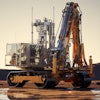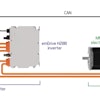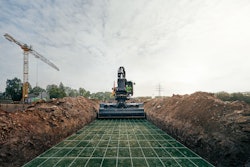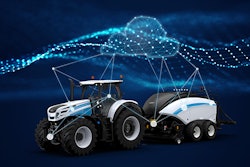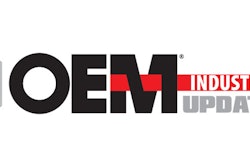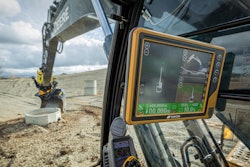
Each year, our State of the Industry issue looks at the top trends and technologies within the heavy equipment industries. We also dig into current and future market conditions, as well as regulations which may currently or in the coming years have an impact on how the industry will go about designing its equipment.
To get the best insights, we speak with executives from a variety of companies working in the industry—everyone from associations, to OEMs to component suppliers. Below are responses provided by Janosch Fauster, Director Application Development Center, and Markus Plankensteiner, Vice President Sales & Marketing, TTControl.
Read all of this year's executive Q&As.
Global Markets, Government & Trade
What are the key global markets your company sees as growth opportunities and why?
Agriculture is certainly one of the key markets predetermined to grow considerably when it comes to electronics and software, in the direction of further automation and autonomy. The combination of complex machinery and labor-intensive processes makes agriculture predestined for expansion in electronics.
Supply Chain Disruptions
If impacted by supply chain disruptions, what has your company done to try to overcome this industry challenge?
The coronavirus pandemic has been a challenging time for the industry. We are proud to have kept an excellent delivery performance of an average of 80-90% up to and including the third quarter of 2021. We put dedicated processes in place to achieve this goal during the current component crisis. The fact that TTControl traditionally invests in large-scale safety stock of all our products to satisfy short-term demands helped as well. Furthermore, we conduct risk analyses as part of hardware development as a basis for second source decisions. With Continental in particular, we have been able to rely on a stable supply over the past few years. Finally, TTControl and its parent companies TTTech Group and HYDAC International have strong relationships with large Electronic Manufacturing Services partners and chip manufacturers. We work with our customers and suppliers for reliable long-term forecasts. And TTTech Group is a premium partner of Infineon, which certainly helps us navigate uncertain periods.
At what point do you foresee the current supply chain disruptions becoming less of an issue?
There are two main reasons for the current supply chain issues in the electronics industry. We are facing a combination of the bullwhip effect in supply and demand triggered by the COVID-19 crisis and actual lockdowns affecting manufacturing sites and transportation routes.
Many manufacturers and distributors cleared a great deal of their safety stock in 2020 and are now looking for material needed for imminent production. They are trying to build up new safety stock, which creates enormous demand. However, this demand is partly artificial.
The production backlog currently piling up will cause issues for several more months, but we believe that the situation will ease in the first half of 2022 unless new lockdowns affect electronics manufacturing, especially in Asia.
What industry challenges have these supply chain disruptions brought to light, and what can the industry as a whole do to overcome them?
I think this crisis showed the need to refine the widely implemented concept of just-in-time production. Lean manufacturing has without any doubt revolutionized modern production, but not all components are created equal.
A company fully optimized for the best-case scenario with the dogma of “keeping no inventory” is extremely sensitive to supply chain disruption. If critical components aren’t available, as is happening in the current crisis, a complete production cycle has to stop. To not be able to deliver a machine worth USD 200,000 because a critical component worth USD 2 is out of stock illustrates the worst-case scenario.
Companies should weigh up the risk presented by following the just-in-time concept for critical, single-source components in return for a relatively low financial benefit.
Diesel, Electric & Other Power Alternatives
How, if at all, do you see the role of diesel engines evolving in the coming years?
Engine makers have been working to reduce diesel emissions for decades. Today’s diesel engines emit 95% less pollution than their low-technology predecessors. This trend will continue and is bolstered by regional and national regulations such as in the USA, the EU and also China that cover off-highway machinery.
On the other hand, there is a clear trend towards electrification and alternative power solutions. Machinery manufacturers who can ensure that any new power is efficient, reliable and able to meet their machinery's duty cycles can benefit from that.
How will electrification—or other alternative energy/power systems—continue to advance in the heavy equipment industry?
Energy density is still a challenge when it comes to the heavy equipment industry. But both fuel cells and Li-Ion energy storage combined with electric drives are now viable solutions for many applications, often as hybrid solutions in combination with combustion engines. Community governments can promote this trend by establishing zero-emission zones, for instance in downtown areas of larger cities.
To name some examples of purely electric, as well as hybrid applications: TTControl was directly involved in providing safety certified electronics and application software for the so-called “VCU” – vehicle control unit – of several projects released in recent times.
Together with Rosenbauer, we worked on the electronic architecture and functional safety of the first Li-Ion-based hybrid fire truck. It can run fully electric, and if needed, be charged via a diesel range extender. We supported Prinoth on an electric snow groomer with both H2 and Li-Ion technology. Hinowa, an Italian manufacturer of aerial platforms and a long-term partner of TTControl, offers flexible engine options: from traditional ICE technology with gasoline or diesel to electric operation when operating in buildings and on construction sites, as well as Lithium-Ion-based for zero-emission zones in cities.
Data, IoT & Connectivity
What will be the best use cases for the Internet of Things (IoT) and data in the coming years?
We see huge potential to improve machine and process management with IoT solutions in the coming years. The collection of data at the point of the machine will increase and enable deeper analysis in the cloud with technologies such as streaming analytics and big data. This will enable machine builders, owners and operators to vastly improve the economic efficiency of their processes.
What potential do you see in the use of artificial intelligence (AI) and augmented/virtual reality (AR/VR) –both for the design and manufacture of products, as well as within equipment?
Emerging technologies will advance machinery development and operator function in the future. On development projects, we already benefit from fine-tuning machine processes, as well as quality control on the equipment. A perception algorithm, for instance, can observe harvested grain quality and automatically optimize the harvesting process.
Sophisticated assistance functions allow less skilled workers to be more efficient, and increase the safety of operators and bystanders by advanced perception systems. Augmented and virtual reality can be of value for operating equipment in remote locations or hazardous environments. A combination of automated propulsion and augmented reality can support the operator in low-visibility scenarios.
What advancements do you see on the horizon for connectivity and machine learning in the next decade?
We expect machine learning to have a positive impact on product costs. Also, some spillover effects from automotive can lead to reduced chip and sensor costs. That will be necessary, since multiple Central Processing Unit (CPU) cores, accelerators and Graphics Processing Units (GPUs) will have to execute the growing number of advanced assistance functions, resulting in an exponential growth in the amount of software. A short time to market can still be ensured, despite facing massive complexity, by relying on certified chips, ECUs and robust software frameworks.
What challenges remain for the continued adoption of data, IoT and connectivity-related technologies or systems?
Technology in emerging technologies is progressing a great deal. The current innovation cycle for some key components is about 2 years, where the new generation outperforms the previous generation by hundreds of percent in every aspect of performance. This fuels challenges relating to obsolescence handling – remember, for example, the switch to 5G on one hand and sunsetting 3G on the other hand.  Markus Plankensteiner
Markus Plankensteiner
The automotive industry postponed its plans for level 4 and level 5 autonomy as a result of the advancements in computational powers and deep neural networks that remained necessary. We think the heavy equipment industry can learn from that experience by setting realistic targets and by better appraising the investments needed to implement our use cases.
Automation & Smart Systems
What further benefits will automation bring to the heavy vehicle and equipment industries?
Many heavy vehicles are expensive, high-tech pieces of equipment used in labor-intensive industries. Skilled operators are scarce, but the highest level of machine performance and safety is still expected. Automated quality control and the automated fine-tuning of operational parameters enable also less experienced operators to achieve high levels of productivity.
Challenges & Opportunities
What are the biggest challenges facing the industry currently, or that you see the industry facing in the coming years?
The industry is transitioning towards “software-based vehicles.” While innovation on the mechanical parts, hydraulics and engines remains important, a large part of the innovation is in the software functions. Today, big OEMs in the off-highway market employ more software engineers than mechanical engineers. This trend will continue and poses many new challenges: can a buyer of a piece of equipment expect frequent software updates adding new functionality, maybe for free, for the next 5-10 years? How can the costs of continuous security fixes be covered? Will “software-defined” heavy equipment also follow the route to software-as-a-service offerings? Maybe the future customer won’t buy the equipment anymore, but only the service the machinery performs.
What are some of the biggest opportunities you see in the industry?
We see an increasing need for technology to support the upcoming industry transition.
Vehicle manufacturers are, for example, challenged to reduce the increasing complexity of software, which can happen by adopting platform solutions allowing several, more efficient software layers.
We address this need with TTControl’s Application Development Center, which provides emerging technologies with knowledge and software development support. Our customers benefit from technology transfer within the TTTech Group that TTControl is part of. This also includes the increasingly important topic of functional safety and the security of modern mobile machinery.
Are there any technologies or trends which you are currently excited about in the heavy-duty vehicle industry, or most looking forward to seeing in the coming years?
There are several very exciting technologies ahead of us. Smart farming will have a profound impact on the daily work of agronomists. Alternative drive systems and electrification are the response to demands for sustainability by growing populations and mega cities. The Internet of Things (IoT), cloud solutions and autonomous operation will unleash completely new potential that will vastly change how we work in the future.
What do you think will be the biggest change to occur in the heavy-duty vehicle and equipment industries in the next decade?
The increasing trend towards alternative drive systems will take over in the mid- and long-term. This development, accompanied by additional trends, will have several positive effects. Emerging IoT technologies will result in higher efficiency, especially for the operation of fleets of vehicles. Smart farming will result in higher efficiency in terms of natural resources. And alternative drive systems will bring about a reduction in CO2 emissions.


